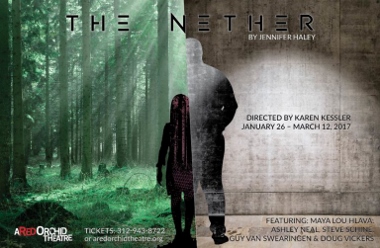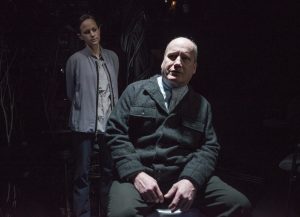FINDING NETHER-LAND
Cryptic and fascinating, Jennifer Haley’s 85-minute one-act The Nether takes its name, if not its inspiration, from an allusion to the afterlife. But, persuasively presented by director Karen Kessler, “The Nether” is in the here and now. It more than rivals reality. A Red Orchid Theatre’s techno-parable reveals the malleability of identity when reduced to binary basics and pretty pixels.
The fear in critiquing this exploration of virtual reality is not that too much might be given away but that not enough was taken in to start with. This show thrives on sharing secrets that only half convince. Certainties dissolve in seconds.
Initially we witness a police interrogation: Detective Morris (Ashley Neal) accuses Sims, creator of an escapist cyber-refuge called “The Hideaway,” of “solicitation, rape and murder.” Specifically, Sims is condemned for providing a sensation-rich wonderland (imaginatively conjured up by John Musial) that caters to the wrong fantasies. Morris sees it as a safe space for pedophile predators and child molesters and a legitimization of abuse. The users of the “Nether” become too attached to the digital delights that “flesh out” their dreams. Either they don’t want to return to reality’”or they shouldn’t.
 Secret agent Woodnut (Steve Schine) has infiltrated this “Nether” playground, only to be seduced by Sims’s apparent daughter “Iris” (Maya Lou Hlava). Also grilled by Morris is Doyle (Doug Vickers), an esteemed 65-year-old teacher who will undergo an even more radical transformation. Attracted to this dark destination (Haley’s action version of The Matrix), patrons are invited to drink cognac, play billiards, enjoy the rare trees, and possibly “cross over.” The “Hideaway” also offers less gentle recreation, including the destructive potential of a very real ax.
Secret agent Woodnut (Steve Schine) has infiltrated this “Nether” playground, only to be seduced by Sims’s apparent daughter “Iris” (Maya Lou Hlava). Also grilled by Morris is Doyle (Doug Vickers), an esteemed 65-year-old teacher who will undergo an even more radical transformation. Attracted to this dark destination (Haley’s action version of The Matrix), patrons are invited to drink cognac, play billiards, enjoy the rare trees, and possibly “cross over.” The “Hideaway” also offers less gentle recreation, including the destructive potential of a very real ax.
The lure of this Westworld spinoff and its seemingly therapeutic interactions is “to live outside of consequence,” with complete freedom and privacy for the unfettered imagination. If “pain drives technology,” the reduction of human choices and conflicts to sheer images and simple actions is irresistible, at least as perversely pictured in this richly duplicitous Nether.
The ultimate goal is to dispense with “physicality” to become pure spirit, a “shade” (yet another death-dealing reference in this next-world “Nether”). But is this a death wish or the next step for evolution?
Depicting their resistance movement to reality, Van Swearingen and Vickers deliver an ambivalent mixture of decadence and defiance. Their obsessions are reminiscent of W.S. Gilbert’s wonderful line, “I know it’s a weakness’”but the weakness is so strong.” Dressed like an android Alice in Wonderland, Hlava’s nine-year-old “Iris” is a sweetly sad case of suspended animation. (Hers is a very one-way lookingglass.) In contrast, the reactions of Neal and Schine’s cops to this criminally creative “Hideaway” run from hostility to capitulation. But can real-world morality impinge on presumably victimless, value-free sheer sensation?
Much here recalls Hans Christian Andersen’s still seminal fairy tale “The Emperor’s Nightingale”: There a mechanical simulation of the bird enchants a Chinese monarch until, nearing death, he sees’”and, too late, values–the real nightingale that the fake one couldn’t supplant. In the 21st century, it seems, the opposite may happen: We expect technology to be more than the art that improves on life: It should replace it. When that happens, no one who saw The Nether can possibly be surprised. Log in at your risk.
The Nether
A Red Orchid Theatre, 1531 N. Wells Ave
Thurs–Sat at 8; Sun at 3
ends on March 12, 2017
for tickets, call 312.943.8722 or visit A Red Orchid
for more shows, visit Theatre in Chicago






